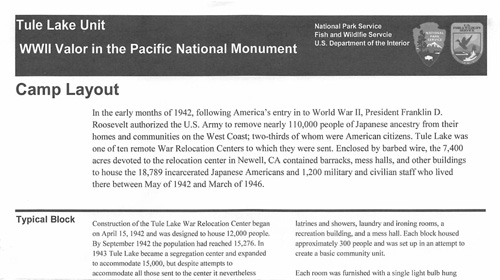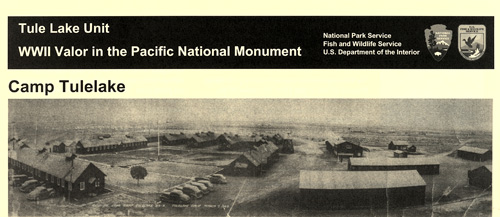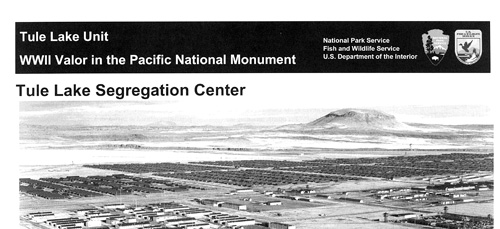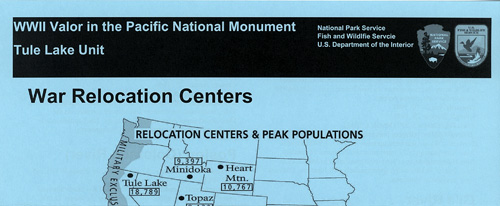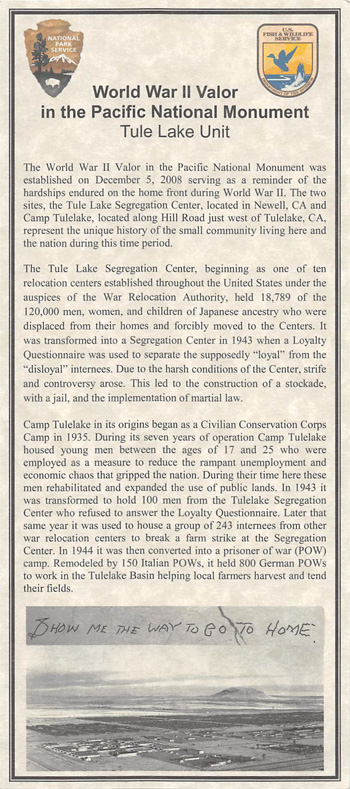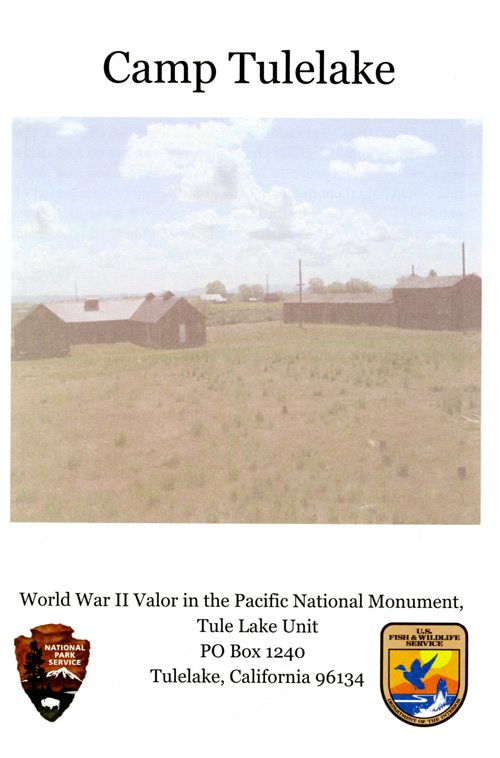|
Tule Lake National Monument California |
 |
 NPS photo | |
War and Injustice
After Japan's attack on Pearl Harbor on December 7, 1941, the lives of 110,000 men, women, and children of Japanese ancestry living on the West Coast drastically changed. Their constitutional rights were violated when they were imprisoned in ten War Relocation Centers* administered by the War Relocation Authority. Many were forced to give up their homes, farms, businesses, and personal property, in addition to their freedom.
*These camps were officially called "War Relocation Centers. " However, during WWII, the media and many Americans referred to them as the "Jap camps," which is now considered to be an offensive racist description. President Roosevelt and other government officials on occasion referred to them as "concentration camps. " Most Americans now know of them as "internment" camps, although that is actually an incorrect usage of that legal term.
Executive Order 9066
On February 19, 1942, President Franklin D. Roosevelt signed Executive Order 9066 authorizing the Secretary of War "to prescribe military areas in such places and of such extent as he or the appropriate Military Commander may determine, from which any or all person may be excluded ... The Secretary of War is hereby authorized to provide for residents of any such area who are excluded there from, such transportation, food, shelter, and other accommodations as may be necessary..."
Assembly Centers
Following the Executive Order, American citizens and resident aliens of Japanese ancestry living in Washington, Oregon, California and Arizona were ordered to evacuate their homes and businesses and report to 17 temporary "Assembly Centers" located at fairgrounds, racetracks, and other makeshift facilities. At these centers, which essentially served as temporary detention facilities, a family usually lived in a single horse stall for up to 100 days with straw-filled bags for beds. The horse stalls were hastily cleaned out before being used as living quarters, and the stench of manure and urine remained. Shortages of food and other materials and deplorable sanitation conditions were common at many of the centers. From these centers, the incarcerated Japanese Americans were then sent to one of ten War Relocation Centers, once they were built.
Ten War Relocation Centers
The War Relocation Centers were located in inland areas away from population centers, frequently on land already owned by the federal government with good transportation linkages. They were designed to be self-contained communities, complete with hospitals, post offices, schools, warehouses, offices, factories, residential areas and farm areas. Of the ten camps constructed, two each were located in California, Arizona, and Arkansas, and one each was located in Wyoming, Idaho, Colorado and Utah. The layout of the camps varied, but certain elements were consistent, including a perimeter defined by guard towers and barbed wire fences. Main roads in the centers were occasionally paved, but most side streets were unpaved and as a result alternated between being muddy quagmires or dry and dusty depending on the weather.
Tule Lake War Relocation Center
The Tule Lake center was designed as a series of blocks. The first 40 blocks each had fourteen residential barracks, a mess hall, a recreation building, a men's latrine, two women's latrines, an ironing room and a laundry room.
Each residential barrack was divided into four to six family rooms, ranging in size from 16 feet by 20 feet, to 24 feet by 20 feet, and sided only with tarpaper. The relentless winds of the Tule Lake Basin drove dirt and dust through the walls.
Each family occupied one room, which was furnished with a single light bulb, a coal stove, and up to eight army cots. Meals were served in community mess halls, which disrupted traditional family life and the strong influences of parents over their children. Latrines were set up military style with no dividers between toilets or shower stalls.
Camp Life
Though conditions were harsh, incarcerated Japanese Americans tried to keep life in the camps as normal as possible. Harvest festivals, dances, and baseball were common recreation activities. Recreation buildings were converted into stores, canteens, a beauty parlor, a barber shop, judo halls, Buddhist temples, a Catholic church, and three other churches.
Loyalty and Segregation
In an effort to recruit Japanese American men for the military and reintegrate incarcerated Japanese Americans back into society, a loyalty questionnaire was distributed to all in the centers in February 1943. The questionnaire included two poorly worded questions intended to determine if Japanese Americans were loyal or disloyal to the United States government.
Question 27 asked draft-age males: "Are you willing to serve in the armed forces of the United States on combat duty, wherever ordered?" For others, including the Issei* and women, it asked "If the opportunity presents itself and you are found qualified, would you be willing to volunteer for the Army Nurse Corps or the WAAC?"
Question 28 asked: "Will you swear unqualified allegiance to the United States of America and faithfully defend the United States from any or all attacks by foreign or domestic forces, and foreswear any form of allegiance or obedience to the Japanese emperor, or any other foreign government, power or organization?"
The loyalty questions seemed innocent enough, but for foreign-born Japanese, who for 17 or more years prior to WWII were not allowed by law to become citizens of the U.S., they were being asked to give up their citizenship to Japan and become nationless people, having no legal ties to any country. For their Nisei** children, who were U.S. citizens by birth, the question became a decision between country and family. Many Nisei felt pressure from their parents to answer with their families, even if it meant expatriating and moving to a country they had never seen. Others simply answered no as a form of civil protest to being imprisoned. Others saw the questions as trick questions designed to force their deportation or to continue their unjust incarceration.
For all of these reasons as well as the poor administration of the questionnaire, 42 percent of the Tule Lake population refused to answer or answered no to questions 27 and 28. Others answered with qualifications such as "Yes, if you free my family." Either a no or a qualified yes caused them to be labeled "disloyal" by the U.S. government.
Since Tule Lake had the largest number of no's and qualified answers, it was decided that all deemed "disloyal" from the other nine centers would be sent to Tule Lake, segregating them from those considered to be "loyal." Those at Tule Lake who had answered yes to the questions were in turn asked to move to the other nine camps to make room for the incoming "disloyals." Of the 8,500 who stayed at Tule Lake, some 4,000 were labeled "loyal," often because they did not want to go into the unknown again. This mix of people labeled "loyal" and "disloyal" would later lead to internal conflicts and prejudice within the center.
*Issei — the first generation of immigrants from Japan, most of who came to the U.S. between 1885 and 1924. Issei were not allowed to become U.S. citizens until 1952.
**Nisei — second generation Japanese Americans, U.S. citizens by birth, born to Japanese immigrants (Issei).
***Nikkei — the combination of both Nisei (U.S. born citizens) and Issei (legal residents) that were residing in the U.S. during WWII.
Tule Lake Segregation Center
In 1943, the Tule Lake War Relocation Center was converted into a high security Segregation Center to house those labeled "disloyal." The population at Tule Lake rose from 15,276 to 18,789 within just a few months. Though additional barracks were built and the camp was expanded, the camp housed almost 4,000 over its intended capacity. This high concentration of incarcerated Japanese Americans created discontent, which grew as security increased and additional soldiers were assigned to Tule Lake. Soon a lighted seven foot high chain link fence topped with barbed wire was added, Army tanks arrived on site, and the number of guard towers around the center was increased from six to 28. The farm areas were also surrounded by a warning fence, a security fence, and 16 new guard towers.
As a segregation center, Tule Lake was a mix of "loyals" with no intention of leaving the United States, pro-Japan Japanese Americans who wished to repatriate or expatriate as soon as possible, and many whose feelings fell somewhere between these extremes. Internal friction between groups as well as with the U.S. Army resulted in harassment, beatings, riots, mass demonstrations, military intervention and occupation.
Martial Law and Imprisonment
As discontent grew within the Segregation Center, the Army took control of the camp in late 1943, declaring martial law on November 13, which lasted until January 15, 1944.
In 1944, the stockade area was established. The stockade consisted of a 250 foot by 350 foot area enclosed by fences and guard towers. Within the stockade were four barracks, a mess hall, a latrine, and Army tents that were used as unheated punishment quarters for some stockade prisoners. To the north of the stockade stood the six-cell concrete jail designed to imprison up to 24 men. At its peak, over 100 men were incarcerated there.
Renunciation
In July 1944, President Roosevelt signed Public Law 405, which allowed U.S. citizens to renounce their citizenship in times of war. By December, only 600 incarcerated Japanese Americans had applied for renunciation. That number would soon grow, as many at Tule Lake felt this law was directed at them and saw it as their only option. Within the camp, groups were organized to prepare young men, many of whom were bom in the US, for a future life in Japan. The Hokuku Dan was established for men 16 to 35 years old, while the Hoshi Dan was for men over 36 years old. Japanese language, history, religion, geography, ethics and songs were taught to those that had never lived in or even visited Japan.
As government misinformation and rumors spread around the camp that those at Tule Lake would not be welcomed back into U.S. society, that they would not find jobs, and that young men would be shipped off to war and families would be separated, the number of those who applied for repatriation grew. Justice Department officials blamed the pro-Japan groups for rumors and fears, and hoped the arrest and removal of key Hoshi Dan and Hokuku Dan leaders would reduce tensions. On December 27, 1944, 70 leaders were arrested and transferred to the Department of Justice Santa Fe Internment Camp.* Soon after, the administration banned all pro-Japanese activities. This reversal led 6,000 US citizens to apply for repatriation. Only a small minority of the renunciants truly wanted to resettle in Japan; many more renounced out of fear caused by the rumors, confusion, and mismanagement of the camp and wanting to keep families together.
By the end of 1945, the other nine centers had closed and the Tule Lake "loyals" had left the center on their own, with the WRA providing minimum assistance. In October 1945, Tule Lake was transferred from the WRA to the Department of Justice with the goal of repatriating all renunciants to Japan by November 15th. Lawsuits were filed to delay the deportations, and the Department of Justice agreed to hold hearings for anyone who wanted to rescind their renunciation. Over 3,000 asked for a hearing. As a result, only 406 were on the list for deportation. The Tule Lake Segregation Center officially closed on March 18, 1946.
*Internment — refers to a legal process in declared wars, in this case applied to the nationals of a country with which the U.S. was at war. Approximately 8,000 Japanese nationals were formally interned by the U.S. Department of Justice during WWII, beginning as early as the night of December 7/8, 1941. Although commonly referred to as "internment" what the 110,000 Japanese Americans incarcerated in the 10 War Relocation Centers experienced is not accurately defined as internment, as the majority were US citizens.
It was determined by the Commission on Wartime Relocation and Internment of Civilians, established by Congress in 1980, that "Executive Order 9066 was not justified by military necessity, and the decisions that followed from it — exclusion, detention, the ending of detention and the ending of exclusion — were not founded upon military considerations. The broad historical causes that shaped these decisions were race, prejudice, war hysteria and the failure of political leadership."
About Your Visit
 (click for larger map) |
Hours & Fees
• 8:00 a.m. to 5:00 p.m. Memorial Day to Labor Day
• No Fees
Features & Programs
Camp Tulelake and Tule Lake Segregation Tours:
• Memorial Day to Labor Day: Weekend Ranger Led Tours
• Labor Day to Memorial Day: Tours Upon Request
Facilities
Visitor Center Desk inside the Tulelake-Butte Valley Fair Office
• Museum
• Information
• Book Store
Source: NPS Brochure (undated)
|
Establishment
Tule Lake National Monument — March 12, 2019 |
For More Information Please Visit The   OFFICIAL WEBSITES |
Brochures ◆ Site Bulletins ◆ Trading Cards

Documents
An Historiography of Racism: Japanese American Internment, 1942-1945 from Historia, Volume 13 (John Rasel, 2004)
Camp Tulelake (Date Unknown)
Confinement and Ethnicity: An Overview of World War II Japanese American Relocation Sites (HTML edition, UW Press 2002 rev. ed.) Western Archeological and Conservation Center Publications in Anthropology 74 (Jeffrey F. Burton, Mary M. Farrell, Florence B. Lord and Richard W. Lord, 1999)
Densho Encyclopedia: Tule Lake
Environmental Assessment: Tule Lake Jail Public Scoping Newsletter: Summer 2014
Final Report: Japanese Evacuation from the West Coast 1942 (J.L. DeWitt, 1943)
Foundation Document, World War II Valor in the Pacific National Monument, Tule Lake Unit, California (January 2015)
General Management Plan and Environmental Assessment, Tule Lake Unit, World War II Valor in the Pacific National Monument (November 2016)
Japanese American Confinement Sites Digital Collection (National Japanese American Historical Society)
Japanese Americans in World War II: National Historic Landmarks Theme Study (Barbara Wyatt, ed., August 2012)
Japanese-American Internment Sites Preservation (January 2001)
Management Plan Planning Newsletter: Summer 2013: Public Scoping • Spring 2014: Public Scoping Comment Summary
Newsletter
2014: February • March • April • May • July • October • November • December
2015: January • April • Summer
Personal Justice Denied: Report of the Commission on Wartime Relocation and Internment of Civilians, Part 1 (HTML edition) (December 1982)
The Evacuated People: A Quantitative Description (1946)
Tule Lake Segregation Center: Historic Jail Restoration Project Environmental Assessment (March 2018)
Words Can Lie or Clarify: Terminology of the World War II Incarceration of Japanese Americans (©Aiko Herzig-Yoshinaga, 2009)
Words Do Matter: A Note on Inappropriate Terminology and the Incarceration of the Japanese Americans (©Roger Daniels, 2005)
Books

tule/index.htm
Last Updated: 01-Aug-2024

